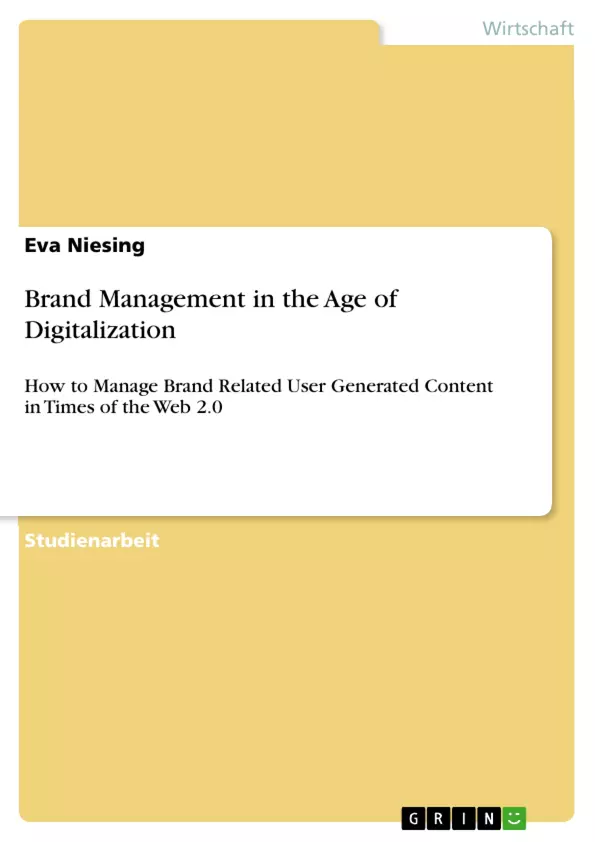“It’s a lonely, scary time to be a brand manager” (Fournier and Avery 2011, p. 193). Fournier and Avery´s statement reflects that the brand management in times of the Web 2.0 has become a very complex and challenging undertaking. In this participatory online environment consumers are empowered to actively take part in the BM process instead of remaining passive receivers of the company´s brand messages. Millions of people create and publish their own brand messages, also called brand related user generated content, in form of for instance YouTube videos, Amazon product reviews, Facebook groups and blog entries. Due to technological advances and the characteristics of the Web 2.0, these contributions from brand fans or brand critics can disseminate quickly and achieve important reach. Consequently, user generated brand messages represent important additional brand touch points next to the company´s brand messages and may have a significant influence on the brand image (Burmann 2010, pp. 1 f.; Musser and O´Reilly 2006, pp. 3-6; Wunsch-Vincent and Vickery 2007, pp. 9-17). Being still in its initial development phase, little knowledge exists on how brand managers should try to maintain the control over the BM process and approach brand related UGC. Instead of maintaining rather passive or simply monitoring these user contribitions, the BM may also counteract or even stimulate them in order to attain brand goals (Arnhold 2010, pp. 49 f.; Burmann 2010, pp. 1-3; Gensler et al. 2013, pp. 242-244; Hennig-Thurau, Hofacker and Bloching 2013, pp. 238 f.).
This paper´s objective is to explain and classify different managerial approaches towards brand related UGC in times of the Web 2.0. Another purpose is to help managerial decision making by giving general recommendations on how to deal with these user generated brand messages. The paper is organized as follows: First, the author introduces a definition and the relevant characteristics of the Web 2.0. Chapter 2 presents the traditional BM process and explains how the Web 2.0 changed it. This theoretical background is followed by the introduction of the concepts of UGC and brand related UGC as well as its management in the third chapter. Based on the development of a new classification of managerial approaches towards brand related UGC, the author describes each approach and gives recommendations to brand managers. Finally, chapter four draws general conclusions and identifies promising areas for further research.
Inhaltsverzeichnis
- 1. Introduction
- 2. Theoretical Background
- 2.1. Definition and Characteristics of the Web 2.0
- 2.2. Traditional Brand Management Process
- 2.3. Brand Management in Times of the Web 2.0
- 3. User Generated Branding
- 3.1. Definition of Brand Related UGC
- 3.2. Classification of Managerial Approaches towards Brand Related UGC
- 3.3. Description of and Recommendations for Managerial Approaches
- 4. Conclusion and Future Research
Zielsetzung und Themenschwerpunkte
Dieses Papier zielt darauf ab, verschiedene Managementansätze gegenüber markenbezogenen nutzergenerierten Inhalten (UGC) in Zeiten des Web 2.0 zu erläutern und zu klassifizieren. Ein weiterer Zweck ist es, die Entscheidungsfindung im Management zu unterstützen, indem allgemeine Empfehlungen gegeben werden, wie mit diesen nutzergenerierten Markenbotschaften umgegangen werden soll.
- Definition und Eigenschaften des Web 2.0
- Der traditionelle Markenmanagementprozess und dessen Veränderung durch das Web 2.0
- Der Begriff des UGC und markenbezogenen UGC sowie dessen Management
- Entwicklung einer neuen Klassifizierung von Managementansätzen gegenüber markenbezogenen UGC
- Beschreibung der einzelnen Ansätze und Empfehlungen für Markenmanager
Zusammenfassung der Kapitel
Das erste Kapitel führt den Leser in die Thematik ein und beschreibt die Herausforderungen des Markenmanagements im Zeitalter des Web 2.0. Im zweiten Kapitel werden die Definition und die relevanten Eigenschaften des Web 2.0 vorgestellt. Anschließend wird der traditionelle Markenmanagementprozess erläutert und gezeigt, wie er durch das Web 2.0 verändert wurde. Im dritten Kapitel werden die Konzepte von UGC und markenbezogenem UGC sowie deren Management eingeführt. Basierend auf der Entwicklung einer neuen Klassifizierung von Managementansätzen gegenüber markenbezogenen UGC, beschreibt der Autor jeden Ansatz und gibt Empfehlungen für Markenmanager.
Schlüsselwörter
Markenmanagement, Web 2.0, Nutzergenerierte Inhalte (UGC), Markenbezogener UGC, Managementansätze, Empfehlungen, Brand Touchpoints, Markenimage, Einfluss auf das Markenimage.
- Quote paper
- Eva Niesing (Author), 2014, Brand Management in the Age of Digitalization, Munich, GRIN Verlag, https://www.hausarbeiten.de/document/277695


